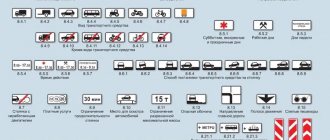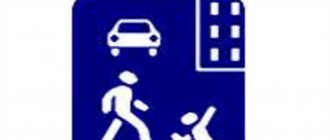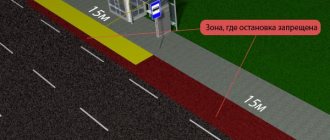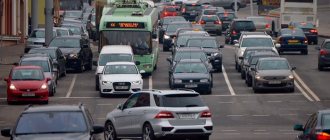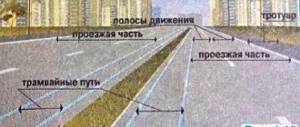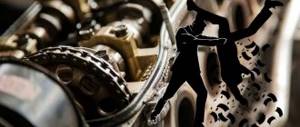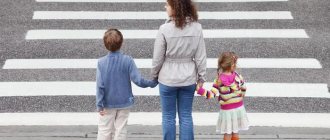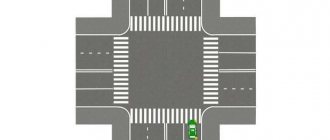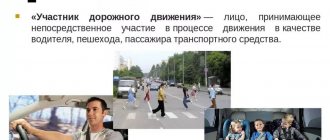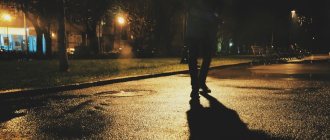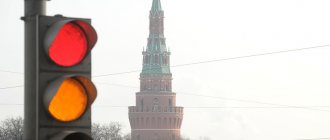- Prohibiting
This group is quite extensive and includes signs prohibiting road users from performing one or another action: speeding up, parking, overtaking or turning. A distinctive feature of these signs is that they are all
round
forms. Penalties for not very serious violations include mainly monetary fines; in other cases, you can easily be left without a driver’s license, for example, for driving into the oncoming lane under a “brick” sign.Only vehicles with special signals and flashing lights can pass prohibitory signs without following the instructions on them. The restriction of a prohibitory sign loses its force at the nearest intersection or when a sign appears that removes the restriction.
- Warning
Triangular shape, white background and red edgingdistinguish this group of signs. The only exceptions are signs associated with railway crossings and indicating the direction of turn.
The instructions on these signs cannot be violated, since they do not prohibit anything, but warn the driver about a dangerous section of the road. Examples of warning signs include warnings that the road ahead is getting narrower or slippery, or that there is a chance of encountering an animal along the way. Usually they are placed at 50-300m
from the suspected danger zone.
3. Priority signs
These signs are a kind of explanation to who should be the first road user to pass an intersection or other difficult section of the route. For violation of this group of signs, mainly monetary fines are provided. Priority signs have different shapes and colors. The basic rule for typing groups of characters does not apply to them. Thus, the “Main Road” sign has the shape of a yellow diamond on a white background, and the “Right of Way” sign is made in the form of a circle with a red edge.
This group includes signs and signs that warn the driver about an upcoming intersection or determine the advantage of passing a narrow path, etc.
4. Prescriptive
For the most part, these include round signs with a dark blue background, which show the direction of movement and inform about pedestrian or bicycle paths and behavior on them.
A separate subgroup consists of rectangular-shaped mandatory signs with a white background for vehicles carrying dangerous goods.
The main task of these traffic signs is to perform certain actions by one or another road user (pedestrian, cyclist or driver).
5. Signs of special regulations
This group of signs combines elements of several groups of signs. Pedestrian crossing signs show pedestrians where to cross and motorists where they need to slow down and be very careful. They also include highway exit signs, public transport-only areas and their stopping points.
Special regulations signs are predominantly rectangular or square
shapes are blue, white or green.
6. Information and service signs
Satisfied large group of road signs, mostly square in shape with a blue background
, which show where you can turn around, park, dead ends, underground passages, etc. They also contain the names of streets, towns, and cities.
In cities, information signs are made in black letters on a white background, on highways - in white letters with a green background, on ordinary roads - in white on blue. The supports for these signs are usually U-shaped
or
L-
shape.
The signs themselves are installed at a height of 5-6 m
from the road surface, in other cases -
0.5 - 2 m
from the ground.
Information signs do not impose any restrictions, they only inform. There are only 2 restricted signs, each of which allows U-turn traffic with a prohibition on turning left.
More recently, service signs (gas station, sockets for an electric car, service station, place to rest), which are purely informational in nature, have also been added to this group. They are installed directly next to a particular object if it is located within the city, and on highways such signs can be located tens of kilometers from the object itself. 7. Plates with additional information
These small rectangular white plates are installed directly under the main sign to clarify it. Fines for violating the instructions of such signs are levied specifically for failure to comply with the instructions on the main sign. But there are cases when traffic police evacuate cars directly from parking lots if they violate the instructions of an additional sign.
What do the warning signs look like?
First, let's look at the features that are inherent in all warning road signs:
1. Traffic warning signs, by definition do not prohibit anything , so it is impossible to violate their requirements even theoretically. That is, it is impossible to receive a fine for violating the requirements of a warning sign.
Nevertheless, you should not relax, because... Warning signs are very often installed in front of sections of the road where you can receive fines for violating other points of traffic rules.
For example, if there is a dangerous turn sign on the road, overtaking is prohibited.
2. Almost all warning signs are a triangle with red sides and a white center.
3. Warning signs in the form of a triangle are installed at the following distances before the beginning of the dangerous section:
| In a populated area | 50 – 100 meters |
| Outside the populated area | 150 – 300 meters |
In addition, if there is a plate 8.1.1, triangular signs can be installed at a different distance from the beginning of the dangerous section.
In this case, the sign is located 300 meters before the traffic light.
4. Some warning signs should be duplicated , but this feature will be discussed later.
Combinations of characters
Information about road work is indicated by other signs. These include:
- “Distance to object” is a white sign with numbers that indicate how many meters are left to the area being repaired. Only used if the Road Works warning sign is placed at a non-standard distance.
- “Traffic light regulation” is a triangle with a yellow background, a red outline and circles imitating the colors of a traffic light. It occurs rarely, usually in the case of large-scale repairs of a major road or junction, where a traffic light was temporarily installed to regulate traffic.
- “Rough Road” is a triangle with a red outline, a yellow background and a black figure with two waves. Warns of holes and potholes in the area.
- “Gravel Burst” is a triangle with a red outline and a yellow background, which depicts a car and flying pebbles. The sign informs you that passing vehicles on a given section of the road may involuntarily scratch your car or its windows, as gravel flies from under their wheels.
- “Dangerous Roadside” is a triangle with a red outline on a yellow background and an image of a car with one wheel stuck in a hole on the side of the road. The sign warns that you must not turn off the roadway or stop in the designated section.
- “Narrowing of the road on both sides” is a triangle with a red outline on a yellow background with the image of two black broken lines converging closer to each other at the top. Warns that due to repairs, the roadway is narrowed by 50 cm or more. You must be prepared to give way to other cars.
- “Narrowing of the road on the right” is a triangle with a red outline on a yellow background depicting two black lines, the left one is straight, and the right one is a broken line. Warns that the right lane is becoming very narrow, and those driving on the left will have to periodically let oncoming cars pass.
- “Narrowing of the road on the left” is a triangle with a red outline on a yellow background depicting two black lines, where the right one is straight and the left one is broken. Informs that the left lane is narrowing; vehicles moving on the right will have to periodically let oncoming cars pass.
- “Other hazards” is a triangle with a red outline on a yellow background and an exclamation point in the middle. Informs the driver about unexpected dangers that arise during road repairs.
- “Maximum speed limit” is a circle with a red outline on a yellow background and a number indicating the maximum allowed speed.
- “End of the maximum speed limit zone” is a circle with a black outline, a yellow background and a gray number crossed out by three stripes. As the name suggests, the sign indicates that the speed limit in effect in the area being repaired is being lifted.
- “No left turns” and “No right turns” are signs in the form of a circle with a red outline, a yellow background and a black arrow pointing to the right or left. It is reported that turning maneuvers are prohibited in the area under restoration.
- “No U-turn” is a circle with a black outline, a yellow background and a black arrow describing a semi-oval. Informs you that you cannot turn around until the problem area is over.
- “Overtaking is prohibited” is a circle with a black outline, a yellow background and an image of two cars, one of which is black and the other is red. It can be either two cars, or a car and a truck. In the second case, the restriction applies to trucks.
- “Avoiding an obstacle on the right (left)” is a blue circle with a white thin outline and an arrow of the same color, indicating the direction in which you can go around the fenced section of the road.
Railway crossing signs
Several road signs are provided to indicate a railway crossing. Detailed information about them is given in a separate article:
Let us consider only the main features of these signs:
Any of the signs listed above informs you that you are approaching a railway crossing.
are duplicated outside the populated area . In this case, the second sign is installed at a distance of at least 50 meters before the crossing.
Signs 1.3.1 and 1.3.2 help the driver find the boundaries of a railway crossing if it is not equipped with a barrier. Information about the boundaries of the crossing is very important, because Special traffic rules apply directly at the crossing.
For example, stopping and parking at crossings is prohibited.
Location
There are several installation options.
Each of them has its own characteristics:
- Directly near the object - without prior warning, if the food point is clearly visible in the direction of travel.
- The sign is preliminarily installed indicating the distance, also on additional. The index may contain data about the name of the establishment, address, etc.
- In a populated area, installation is allowed 150 meters before a point or at a turn (intersection) leading to a given point.
- On the highway it is possible to install at a distance of 400 to 800 meters if the object is located in the direction of travel, and in advance - 15-20 or 60-80 km if the object is located away from the road. In this case, the distance to the turn is taken into account.
Traffic light regulation
The image of a traffic light in a red triangle warns of approaching a section of the road where a traffic light or traffic lights are installed:
Note. This sign is used when traffic lights have recently been installed at an intersection or pedestrian crossing that has been unregulated for many years.
This sign should additionally inform the driver, who, out of habit, may not notice the newly installed traffic lights.
So if you come across a 1.8 sign on the road, pay attention to it. Most likely you will encounter a traffic light in an unexpected place.
Also, a traffic light regulation sign must be installed in populated areas if the visibility distance of the traffic light is less than 100 meters.
Release forms
Currently, all signs included in traffic regulations are made on a metal base, which is coated with a special reflective compound. This makes the sign visible at any time of the day. In some cases, LED contour lighting may be used. It is provided either by miniature incandescent lamps or the more common LEDs.
The revision came into force on November 5, 2014.
Changes were made in accordance with Decree of the Government of the Russian Federation dated October 24, 2014 No. 1097.
Warning signs inform drivers that they are approaching a dangerous section of the road, driving along which requires taking measures appropriate to the situation. The numbering of road signs corresponds to GOST R 52290-2004.
Priority signs establish the order of passage through intersections, intersections of roadways or narrow sections of the road.
Prohibition signs introduce or remove certain traffic restrictions.
Compliance with the requirements of prescriptive signs is mandatory if traffic management is not carried out by a traffic controller.
Special regulations signs introduce or cancel certain traffic modes.
Information signs inform about the location of populated areas and other objects, as well as established or recommended traffic modes.
Service signs inform about the location of the relevant facilities.
Additional information signs (plates) clarify or limit the effect of the signs with which they are used.
Identification signs or plates serve to limit or clarify the effect of the sign with which they are used.
Information about road signs
A road sign, or traffic sign, is a graphic design made in accordance with certain standards and installed near the road in order to bring certain information to the attention of road users.
The role of road signs in ensuring traffic safety is extremely large: they inform drivers about dangerous sections of the road, oblige them to reduce speed, prohibit overtaking where it is associated with an increased risk, and perform many other useful tasks. Modern standards that determine the appearance of road signs, as well as markings and traffic lights, came into force in our country on January 1, 2006. The updated signs are fully compliant with the UN Convention on Road Signs and Signals and the latest European standards in the relevant field.
The traffic rules, which regulate in detail issues related to road signs, define eight categories:
- warning: they are triangles with a white background, red border and black drawings. Designed to warn traffic participants about danger;
- signs of priority right of way: determine the order of passage of bottlenecks and intersections;
- prohibitory and restrictive signs: made in the form of a white circle with a red border and a black pattern. Prohibit certain actions;
- mandatory signs: have a round shape, blue background and white drawings. Prescribe the performance of certain actions;
- signs of special regulations;
- information signs: have a rectangular shape and blue (sometimes green) color. Used to inform traffic participants about the location of lanes, the nature of the road, service companies and much more;
- information and directional signs;
- additional signs (plates): supplement the main signs listed above, never used separately. They have a rectangular shape and a white background; the design and edging are black.
The current version of the Traffic Rules determines the priority of signs over road markings. If markings and road signs contradict each other, the driver must be guided by the requirements of the latter.
Dangerous bend
These signs indicate that there will be a sharp turn on the road in the near future.
The dangerous turns sign has a similar meaning, with the only difference being that it informs about the presence of several turns in a row:
If you come across one of the signs listed above, then you should immediately remember paragraph 11.4 of the traffic rules, which prohibits overtaking, including on dangerous turns.
For overtaking on a dangerous turn, the driver may be subject to a license deprivation for a period of 4 to 6 months.
Please note that only signs 1.11.1 – 1.12.1 are a sign of a dangerous turn from the point of view of traffic regulations. There are no other ways to understand that a turn is dangerous.
I would also like to remind you that if overtaking was completed before the start of a dangerous turn or started immediately after it, then this is not a violation of the rules (if there are no other prohibiting conditions).
Priority signs
Since the road sign indicating the main road is in the group of priority ones, it would be useful to understand what their essence is. The group is relatively small, but at the same time it has no less importance in traffic rules than a warning one.
Which signs are priority:
- Main road – defines the area where the right of way is provided. Used at intersections without regulation.
- End of main road sign – used to indicate the end of the main road.
- Intersection with a minor road – informs you about the intersection of your road with a minor road at the next intersection.
- Junction of a secondary road - its meaning coincides with the previous sign. The difference lies in the adjoining of the road to yours from one of the directions.
- Give way - at an uncontrolled intersection you must not interfere with the movement of motorists moving along the main road.
- Driving without stopping is prohibited - analogous to the sign of giving way. Requires you to stop before crossing an intersection.
- The advantage of oncoming traffic is that it is installed on narrow parts of roads. The sign requires you to give way to motorists in the oncoming lane.
- Advantage over oncoming traffic, on the contrary, provides the right of passage on a narrowed road. But if oncoming cars have already entered the lane, you need to let them pass.
This is a complete list of priority signs that motorists need to know. They do not prohibit, but give instructions for action.
Now let's take a closer look at what a secondary and main road is, and how to understand the sign that marks it.
Requirements of road sign 2.1
When we see a yellow diamond on a white background, we understand that a main road is organized on this section of the road. What does this mean for us?
We can safely move in the direction of the main road, cross intersections and secondary roads without taking into account the “interference on the right” rule.
Why is the sign shaped like a diamond? Surely, when studying traffic rules in a driving school, the teacher explained the meaning of the signs and the geometric shape of the signs used.
There are situations when there is insufficient visibility caused by heavy rain, blizzards, darkness on sections of roads without lighting. Therefore, in addition to memorizing the backgrounds of the image, we also store in our memory the geometric shapes of the characters.
At least three sign shapes are important when crossing an intersection: the diamond, the inverted triangle, and the octagonal sign.
Even if the images of the signs are not visible, we perfectly understand their meaning and what the driver on the right or left of us at the intersection will do.
In this case, we will move unhindered, having priority in traffic, but it is worth looking around and remembering the problems that there is transport that uses priority in traffic, despite the instructions of the signs (ambulance, Ministry of Emergency Situations, police).
Who will have the advantage?
On the road you can often find that the advantage sign will be accompanied by a certain trajectory of movement.
For example: The road will turn left, so the advantage will be on it. In this case, it is important to take into account that when a motorist wants to continue driving straight, he will also have priority over other road users.
Common traffic situations:
- When there are working traffic lights at an intersection where a priority sign is installed, you should first of all focus on them. Signs here are necessary in case the traffic light is not functioning, this happens, for example, at night.
- If no signs are installed when approaching an intersection, then the priority direction will be determined by the road surface, or by the right-hand rule.
